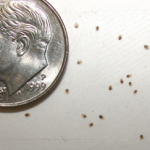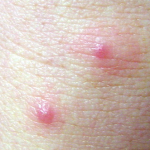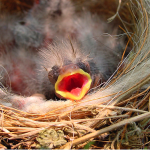Ask any exterminator how to get rid of bird mites and they’ll give you some pretty good advice. “Get rid of the nest and you get rid of the mites.” Well I’m happy to say that this can and does work if you catch it quick enough and you indeed only have one source or nest. While some report bird mites can feed on humans the truth is they’ll only last a few weeks without a bird as a host but they do bite and it is very irritating. The itching and redness can last for weeks and most who are bitten have a feeling of invisible crawling things on them which would drive anybody mad after awhile.
Avian mites are parasites of birds, ANY bird and feed off the host much like a bed bug. They are clear or white in color until they feed where they’ll turn reddish brown. Their numbers can get up in to the tens of thousands with just a small nest of birds as hosts and can literally infest the walls, carpets and any surface. The more nests, the more mites and the more sleepless nights you may have. Mites are most active from sundown to sun up and tend to stay inactive on hot dry days. The mite is very small but with a little magnification you can spot them. They are known to infest bird seed containers and if you look very close you can see the movement of heavily infested seed storage.
How to get rid of mites
As mentioned you should remove any and all nests including those outside. Normally this doesn’t include the one high up in a tree so don’t go there but often times we allow a bird to build it’s nest just outside our window or up in a gutter so we can have the pleasure of watching them build and raise their young. This is the most classic way that a home gets infested and since the little buggers are most active at night you could be losing sleep and having reactions all in the name of watching nature at its finest. Other times the nest is not so easily located and places like the attic should be checked. I’ve seen where birds have built on or next to air ducts in the attic and the tiny mites either enter the ducts through a hole or simply find there way down in the home through the drywall cut outs for ceiling lights such as recessed lighting. Removing the nest is again paramount but treating this area can be difficult with all the insulation that provides cover.
don’t go there but often times we allow a bird to build it’s nest just outside our window or up in a gutter so we can have the pleasure of watching them build and raise their young. This is the most classic way that a home gets infested and since the little buggers are most active at night you could be losing sleep and having reactions all in the name of watching nature at its finest. Other times the nest is not so easily located and places like the attic should be checked. I’ve seen where birds have built on or next to air ducts in the attic and the tiny mites either enter the ducts through a hole or simply find there way down in the home through the drywall cut outs for ceiling lights such as recessed lighting. Removing the nest is again paramount but treating this area can be difficult with all the insulation that provides cover.
Soap and water is probably your best friend to combat bird mites. Borax can be quite effective and can be safely used on many surfaces. Scrubbing the exterior window sill or using a hose end sprayer if it’s up to high will kill many of the mites and what it doesn’t get it should displace rinsing them harmlessly to the ground where they will soon die if they do not find another host. Inside scrubbing should include the general area and make sure to get some mix in the tiny cracks and crevices where you can. Mites hide out in those spots and will live through the ordeal if they are passed up. Steam cleaning the carpets in the same area (room) is also highly recommended.
 Now scrubbing drywall or up in the attic is not practical and will cause water staining with to much application. For this type of area or say around your computer desk with all those cords you might want to use a pyrethrum aerosol. CB 80 or 40 aerosols would do nicely and give you instant relief. There is no real residual with these products so re-application may be necessary. Laundering any bedding or curtains helps out greatly and make sure to check any pets bedding in the vicinity as well.
Now scrubbing drywall or up in the attic is not practical and will cause water staining with to much application. For this type of area or say around your computer desk with all those cords you might want to use a pyrethrum aerosol. CB 80 or 40 aerosols would do nicely and give you instant relief. There is no real residual with these products so re-application may be necessary. Laundering any bedding or curtains helps out greatly and make sure to check any pets bedding in the vicinity as well.
What to do if it’s your bird?
The best way to check for mites in a bird cage is to put a light sheet over and on the floor around the cage for the night. If you have what looks like pepper splattering in the morning you most likely have mites infesting your bird. (you can also use this white sheet in other areas to test for mites) At this point you need to really clean that cage from stem to stern. Birds are very susceptible to insecticidal sprays especially so close and for that reason I would not spray anything. You should at this time check the seed storage bin and throw it away if you have mites in there. You can freeze the seed for a week or so to kill the mites but why chance it? Anything like climb ropes should be discarded and the bird will need a vet to have anything done to it. Continue to use the sheet for monitoring for a week or more afterwards so you can be sure you’ve gotten all of them.
Still have mites?
If after all this you still have the pesky avian mite it is time to call in a pro. It’s not an everyday occurrence for most companies  (including mine) to get that call and I’ve found more mites that the people didn’t even know they had than I’ve gotten calls for. In most cases it rarely takes more than removing the nest and treating with the flushing aerosol. One call did involve mites in a duct-Not wanting to spray inside the airway we simply cleaned what we could, repaired the duct and taped off the open vent. The tape captured a ton of mites that got blown to it every time the air went on and the problem was solved.
(including mine) to get that call and I’ve found more mites that the people didn’t even know they had than I’ve gotten calls for. In most cases it rarely takes more than removing the nest and treating with the flushing aerosol. One call did involve mites in a duct-Not wanting to spray inside the airway we simply cleaned what we could, repaired the duct and taped off the open vent. The tape captured a ton of mites that got blown to it every time the air went on and the problem was solved.
I’ve read horror stories on the web about whole house fumigations as the only answer to help these poor tortured people. Well, I don’t know if you can believe everything you read on your computer screen but could it get that bad? Well, it is possible I guess but I’ve never seen it. I guess you could say, it just mite.




